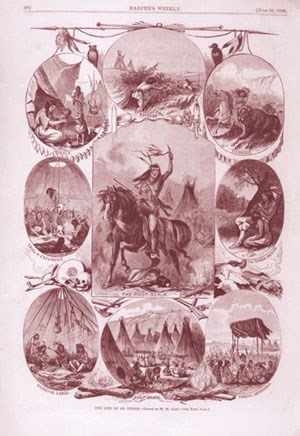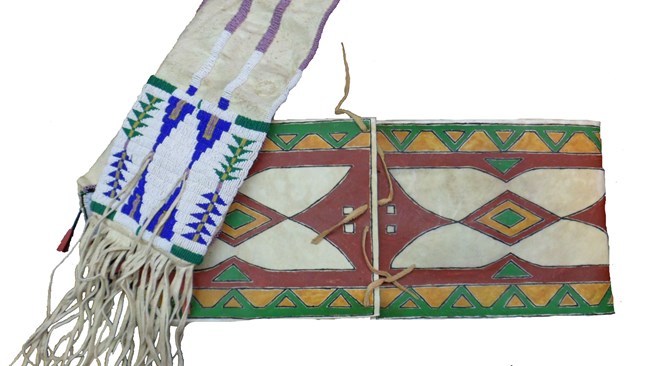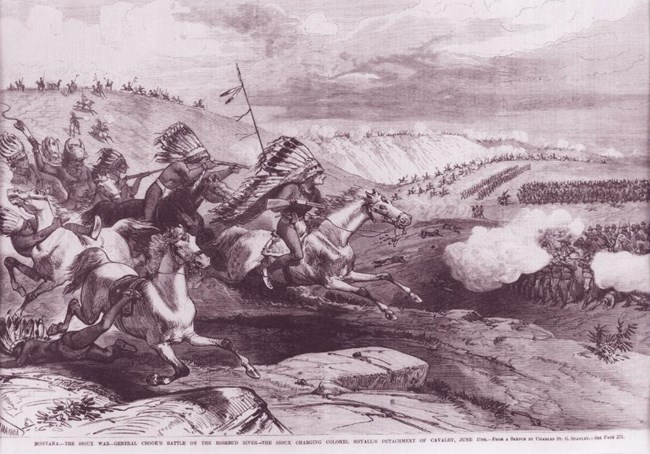Last updated: November 24, 2020
Article
The Plains Indians
Some of these tribes were mobile, ranging over a large region in pursuit of bison. Many were also raiders, stealing horses and various goods from other tribes. Other tribes were settled agriculturists, raising crops in fertile river valleys, and also spending some time hunting bison. And the horse itself, what many people consider the defining characteristic of the Plains Indians, was actually a fairly new addition to their lifestyle.

NPS

Public Domain
The most important change horses brought to these tribes was the ability to abandon permanent villages and travel over the Great Plains to hunt bison. Before the horse, few tribes settled or traveled outside major river valleys because of the enormous distances involved, and the difficulty of hunting bison on foot.
Abandoning permanent or semi-permanent villages for a mobile lifestyle meant owning and carrying fewer possessions. Though known as great artists, most of the artwork of a majority of Plains Indian tribes tended to be decorations on things they carried with them and used for daily life, including tipis, clothing, carrying cases, pipes, religious items, and musical instruments.

NPS
Paints came from iron—containing ores for brown, red, and yellow, plants, which provided various dyes, and black earth and charcoal for black. The paintings and decorations were more a means of communication than art. And, as with other aspects of their lives, what shapes or colors they used and what they meant differed from tribe to tribe. Although some patterns might be common throughout the region, there were tribal differences, and certain tribes tended to favor certain patterns.
Men usually preferred realistic forms such as battle scenes or great accomplishments, while women worked in geometric designs. Their embroidery work with quills and, later, beads tended to show more variation in the designs than the paintings. However, more elaborate designs did not become commonplace until the availability of cheap and abundant glass and china beads.

Public Domain
By 1840, the Plains Indians who adopted the horse reached the height of their development as nomads exploiting bison on the plains.
Europeans were moving slowly, but steadily, into their territory. These newcomers did offer some benefits for the tribes. They brought trade items that made life easier, such as metal-tipped arrows, metal tools, pots and pans, guns, and cotton and wool cloth.
In the beginning they were so few in number they didn't seem like much of a threat. And since they brought things that improved the lives of the Indians, they accepted them. The traders did bring whiskey with them, which help contribute to the eventual downfall of the Plains tribes.
After 1840, the trickle of Euro-American settlers and traders moving into the Great Plains became a flood, one that the Indians were unable to hold back. Although they would fight back and even win a few battles, they would eventually be defeated by the sheer numbers arrayed against them.
Eventually, the Plains Indians were forced to submit to the U.S. government policy of removal to reservations where they were encouraged to abandon hunting and gathering for farming and herding. They were also given annuities, including food, tools, clothing, and blankets, in exchange for giving up more and more of their territory.
By 1900 the days of the Plains Indians were over. The tribes were confined to reservations, and their culture and heritage had been taken away by government agents, missionaries, teachers, and merchants. The Indian Citizenship Act of 1924 granted U.S. citizenship to all Indians, and all adult Indians were granted the right to vote in 1948.
